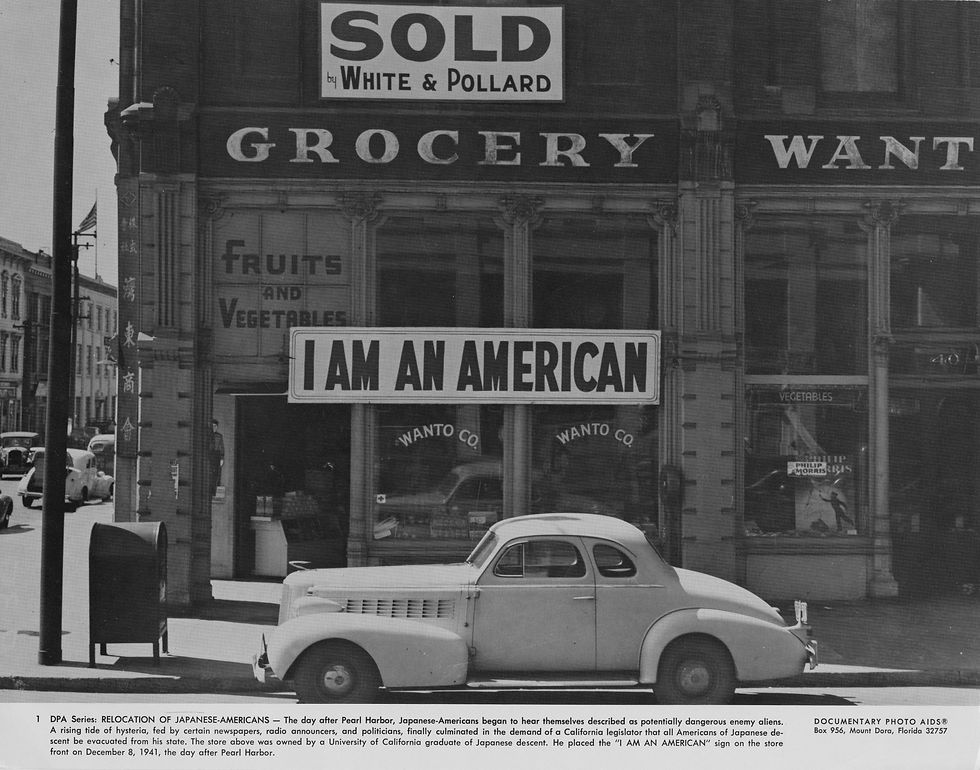December 7, 1941: The Day That Shaped Shinkichi’s Life
- taneatajiri
- 23 sep
- 4 minuten om te lezen
Bijgewerkt op: 8 okt
On the morning of December 7, 1941, the weather at the naval and air bases in Pearl Harbor, Hawai‘i, was partly cloudy. The U.S. Weather Bureau in downtown Honolulu reported a temperature of 73°F (23°C) at 7:30 a.m., with a light breeze. Eyewitnesses recalled it as a beautiful Sunday morning with bright blue skies and hardly a cloud in sight. No one could have imagined what was about to happen when Japan launched its surprise attack, drawing the United States into World War II. The first bombs fell at 7:55 a.m., and the attack lasted until 9:20 a.m., catching both military personnel and civilians off guard.
The Honolulu Star-Bulletin was likely the first newspaper to cover the attack, filling its front page with the breaking news: War! Oahu Bombed by Japanese Planes. The attack and subsequent declaration of war brought immediate, catastrophic changes for Japanese Americans who had built lives in Hawai‘i and on the West Coast.

In Hawai‘i, as on the mainland, the army, FBI, and local police acted within hours, rounding up leaders of the Japanese community who had long been under suspicion, often without charges or warrants. Many were told they would be gone only a few hours, yet most remained detained for the entire war. President Franklin D. Roosevelt invoked the Alien Enemies Act to authorize the detention and confiscation of property. Radios and cameras deemed “contraband” were seized, curfews imposed, and suspicion toward immigrants and citizens of Japanese descent intensified. Similar actions were taken against German and Italian nationals, and by February 1942 thousands were in custody.
Left: FBI agents arrest Japanese civilians, including community and religious leaders, during the first mass removals following the attack on Pearl Harbor, December 7, 1941, Terminal Island, California. Courtesy of the Los Angeles Daily News Negatives Collection, Department of Special Collections, Charles E. Young Research Library, UCLA. / Right: A policeman frisks a Japanese man arrested in a roundup after Japan's attack on Pearl Harbor. Courtesy of the Associated Press.
The Tajiri family was living in San Diego at the time. The household included Shinkichi, his mother Fuyo, sister Yoshiko, and two younger brothers Tom and James. That day happened to be Shinkichi’s 18th birthday, a day he later described as “the climactic end to my youth.”
“It was Sunday morning. I was out playing touch football with some friends when someone came over and said we were at war with Japan.” Radio broadcasts in San Diego carried the shocking news. In a letter to his friend Taz Itow, written that day, Shinkichi wrote: “I just learned from the radio of Japan’s attack on the Hawaiian Isles. Hope this doesn’t really mean war…”
Years later, in a 1991 letter to my aunt Rea Tajiri, Shinkichi reflected: “My mother was about 46, looked 36. The rest of us looked like innocent teenagers, not terribly menacing. Still, there was a change in the attitudes toward us in the neighborhood. Nothing outwardly hostile. Just a kind of curiosity, wondering what was going to happen to us. Whereas before we were mostly ignored and slightly out of focus, the war brought us clearly into view and sharply defined.”

To prove their loyalty, many Japanese Americans responded to the war effort with extraordinary commitment. In Hawai‘i, community members volunteered as block wardens, Red Cross workers, firefighters, medical staff, and laborers, often while holding down more than one job.
The December 1941 issue of the Pacific Citizen featured a message from secretary Mike Masaoka, offering guidance for the community during these uncertain times. Page 4 included a list of Do’s and Don’ts: Be patient. Be calm. Be confident. Be alert. It advised everyone to carry identification and urged Nisei (second-generation Japanese Americans) to always carry their birth certificates and avoid public gatherings. It also encouraged volunteering for Civilian Defense, the Red Cross, and other civic duties. The Don’ts ended with: “Don’t feel sorry for yourself. The misery spreading through the world isn’t going to be relieved by self-pity. Roll up your sleeves and go to work.” And: “Don’t let us down. The attitude of the public depends on your actions. This is the testing time. America too needs every man doing his job to defeat the foe.”
This spirit of resilience, of not giving up but moving forward, is something I have recognized in that generation of my family. Even after enduring trauma and discrimination, they found ways to motivate, educate, and better themselves.
For Shinkichi, the attack on Pearl Harbor marked not only the start of America’s involvement in the war, but also a traumatic turning point in his own life. As an artist, he later spoke of his “need to purge himself of the horrors of the war.”
Reading the letter he wrote on the day of the attack, 83 years later, still feels surreal. In retrospect, without knowing how profoundly this event would shape his life as both a person and an artist, his words carry a deeper meaning. In that same letter, he wrote about his classes with artist Donal Hord and reflected on the commercial art world, which at the time focused on cartooning: “You pick up a magazine, see a beautiful ad or a funny cartoon, enjoy it, and then forget it. But in sculpture, a good piece can be enjoyed for generations.”
As his granddaughter, it brings me great joy to share his story and legacy and to help ensure that his sculptures can be appreciated for many more generations.










